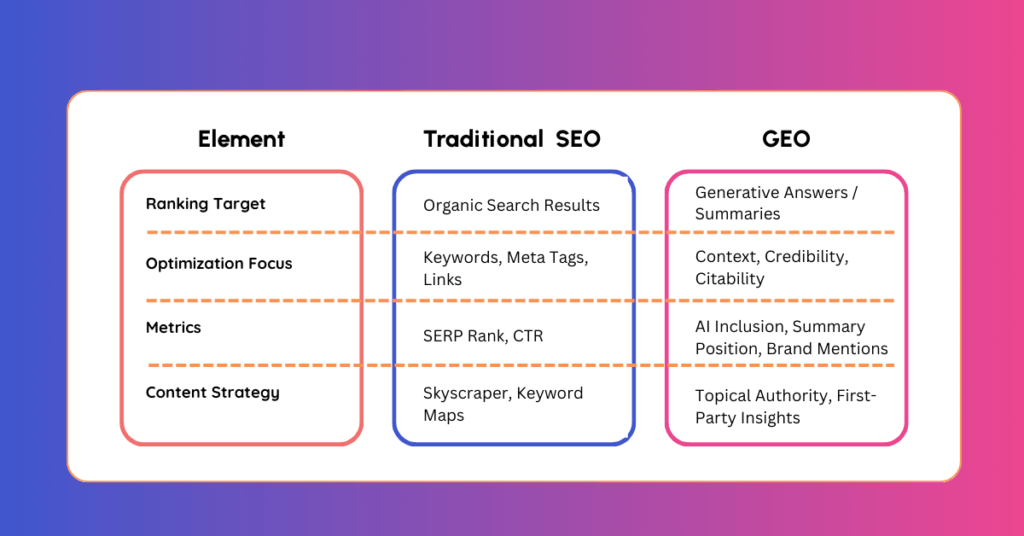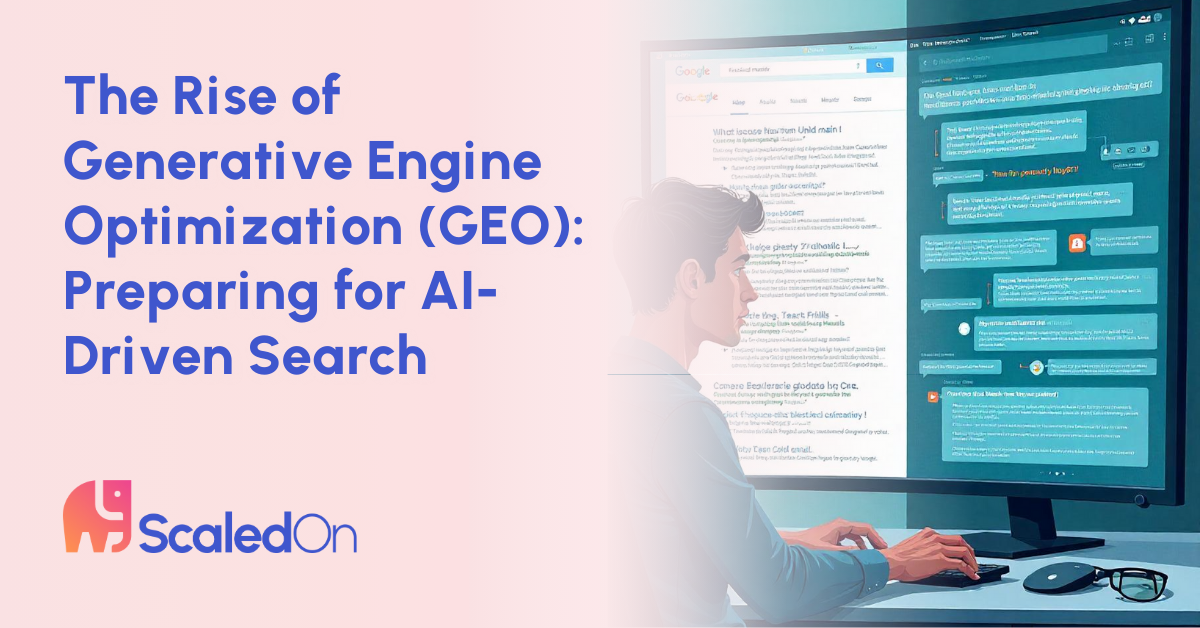Search is evolving—fast. As AI-generated content begins to dominate the top of search results pages, marketers, SEOs, and content strategists are facing a critical new challenge: how do you optimize for generative engines rather than traditional blue links?
Welcome to the new frontier of digital visibility: Generative Engine Optimization (GEO).
In this post, we’ll unpack what GEO is, why it matters, and how your brand can adapt now to stay ahead. Whether you’re an eCommerce leader, a multi-location retailer, or a service-based business, the generative era is already reshaping how your customers find and engage with content.
Table of Contents
1. What is Generative Engine Optimization (GEO)?
Generative Engine Optimization (GEO) refers to the practice of optimizing content to perform well in AI-driven search environments like Google’s AI Overviews, Bing’s Copilot, and other generative AI interfaces. Unlike traditional SEO, which targets rankings in standard SERPs, GEO focuses on ensuring content is visible, cited, or summarized accurately within generative responses.
Think of GEO as answer optimization for AI agents that synthesize results—not just link to them.
2. Why GEO Is the Natural Evolution of SEO
AI is no longer a behind-the-scenes ranking factor. It’s now front and center of the search experience.
With AI Overviews showing up for more than 80% of informational queries in some industries, traditional “10 blue links” SEO is no longer the whole game. Brands that once owned the top organic spots are seeing their click-through rates (CTR) decline as AI takes over the first interaction with the searcher.
This shift doesn’t mean SEO is dead—it means it’s evolving. GEO is about earning a seat in the AI-generated answer, and ensuring your brand voice shows up when it matters most.
3. What’s Powering This Shift? Meet Google’s AI Overviews & Bing Copilot

Let’s break down the big players:
- Google AI Overviews: These generative summaries pull information from multiple sources and present a synthesized answer, often above organic results.
- Bing Copilot: Microsoft’s Copilot integrates ChatGPT into its search, offering rich, conversational responses sourced from across the web.
- Perplexity AI and You.com: Other engines are gaining traction by prioritizing AI synthesis over traditional search rankings.
For brands, this means: you need to write content that machines can cite.
4. How AI Search Engines “Read” Content
AI engines don’t just scan your H1s and metadata. They interpret meaning across the full content spectrum, including:
- Contextual signals (E-E-A-T: Experience, Expertise, Authoritativeness, Trustworthiness)
- Structured data and schema
- Semantic relationships
- Internal and external linking
- User engagement metrics
5. GEO vs. Traditional SEO: What’s Changing?

6. Key GEO Optimization Strategies
To futureproof your content for generative engines, you’ll need to:
✅ 1. Be the Source
AI models prefer to cite original, authoritative sources. Publishing unique data, expert quotes, or firsthand experience increases your chances of being cited.
✅ 2. Optimize for Contextual Authority
Topical depth > keyword density. AI looks for expertise across a cluster, not just individual pages. Use topic modeling to build content hubs.
Learn how we build SEO content clusters that support GEO success.
✅ 3. Use Structured Data
Schema markup makes your content machine-readable. Add FAQ, How-To, Article, and Product schema wherever possible.
✅ 4. Include Natural Language Q&A
Include conversational questions and clear, concise answers within your content. These are prime candidates for AI snippets.
✅ 5. Brand Mentions Matter
AI likes reputable brands. Cultivate entity recognition by building backlinks, co-citations, and digital PR campaigns that strengthen your brand’s semantic presence.
7. Content Formats That Thrive in the Generative Era
Not all content performs equally well in generative engines. These formats tend to win:
- Expert roundups with quotable insights
- Listicles (e.g., “7 Ways to Prepare for AI SEO”)
- Step-by-step guides with clear formatting
- Statistical posts with proprietary data
- FAQs that directly address common questions
- Glossaries that define complex terms
8. GEO for E-Commerce and Multi-Location Retail
For eCommerce businesses, GEO isn’t just about blog content—it’s about product visibility. Use these tactics:
- Add product schema for every SKU.
- Include original product descriptions, not just manufacturer copy.
- Create category-level content hubs to show topical depth.
- Optimize store location pages with unique content for each area.
Need help optimizing your eCommerce footprint? Our eCommerce SEO experts are here to help.
9. Tools, Metrics, and Futureproofing
GEO Tools to Try
- SurferSEO + ChatGPT: To structure content for AI readability
- AlsoAsked / Answer the Public: To find Q&A opportunities
- Semrush / Ahrefs: For content gap and topical authority analysis
- Google Search Console: Watch for sudden CTR drops on ranking pages
GEO Metrics to Monitor
- Brand mentions in AI Overviews
- Organic CTR trends in Search Console
- Indexed content depth and topical coverage
- Entity recognition and structured data errors
10. GEO Checklist for 2025 and Beyond
Use this checklist to get your content ready for the generative future:
✅ Publish original data or expert quotes
✅ Add structured schema markup (FAQ, Article, Product)
✅ Use clear Q&A formatting
✅ Build internal topical clusters
✅ Strengthen brand entity presence
✅ Monitor AI Overview visibility and CTR drops
✅ Keep a human voice—AI cites authentic, helpful content
✅ Include summaries that generative engines can lift
✅ Avoid fluff—brevity is better for citations
✅ Track your brand in ChatGPT, Bing Copilot, and Google AI Overviews
Need help checking all the boxes? Let’s talk about your GEO-readiness.
11. FAQ: Generative Engine Optimization
SEO focuses on ranking content in search engine results. GEO focuses on ensuring your content is visible, trustworthy, and cited within AI-generated summaries and conversational responses.
Yes! Start by updating posts with clear summaries, adding structured data, and enriching them with original insights or FAQs. Also, improve internal linking to build topical authority.
No. While Google is the biggest player, Bing Copilot, ChatGPT search plugins, and other tools like Perplexity AI also use generative models. GEO is a multi-platform strategy.
Track changes in CTR on high-ranking pages, monitor whether your brand is cited in AI answers, and evaluate topical authority using SEO tools. There are no perfect metrics yet—but proxies like engagement, visibility, and brand mentions matter.
No—but it will augment it. SEO isn’t going away. But GEO is the layer that ensures visibility within AI answers, not just placement in rankings.
Final Thoughts: The Time to Act on GEO Is Now
Generative engines are here—and they’re changing the rules. Waiting to adapt could mean falling behind. Brands that move first on GEO have the opportunity to define how their niche is summarized by AI and how users experience their expertise.
ScaledOn can help you create futureproof content that aligns with both traditional and generative engines. We combine real SEO expertise with hands-on AI tools to help you thrive, not just survive, in this next era of search.
📩 Book a free GEO content audit with our team and let’s build your AI-ready content strategy together.

